
Original Link: https://www.anandtech.com/show/1127
Soltek NV400-L64: Purple, Practical, AND Performance!
by Wesley Fink on August 11, 2003 10:26 PM EST- Posted in
- Motherboards
When NVIDIA announced they would be introducing a single-channel version of their newest nForce2 Ultra 400 chipset, it was clear that NVIDIA wanted a lower-priced offering to compete with VIA’s KT600 chipset. Since NVIDIA’s explosive growth in the Athlon chipset market, VIA has been fighting back with lower prices on their current and new chipsets. The nForce2 400, then, would be a lower-cost Northbridge, combined with the lower-end MCP Southbridge, to fight VIA without compromising NVIDIA’s top-line nForce2 Ultra 400/MCP-T offering.
This was all logical enough, and seemed like a good strategy for NVIDIA. The nForce2 400 would be a cheaper, entry-level chipset with lower single-channel performance - or so we thought! Imagine our surprise when early looks at the single-channel nForce2 400 chipset were reporting that the single-channel version was actually FASTER than the dual-channel nForce2 Ultra 400 in many situations. We had not planned for more than a news report of this "value" chipset, but with what we were hearing about the nForce2 400, we wanted to take a closer look ourselves at what all the fuss was about.
The name that was mentioned wherever we saw reports of the nForce2 400 chipset was Soltek, a name many of you may not know. While Soltek appears to be first to market with a single-channel nForce2 board, we have recently learned that Asus and Chaintech now have nForce2 400 offerings, and other companies may also be producing single-channel nForce2 boards in the near future.
Soltek is a name that is well-known to many in Asian markets. There, they have built a solid following and a reputation for building high-performance motherboards at reasonable prices. Soltek is less known in the US market, and this has been compounded by the ongoing reports of Soltek entering the US market and then withdrawing from the US market. Even with this confusion about US market presence, there have been several retailers who have consistently offered Soltek products in the US; so, they are available, but you have to search a bit to find them. Soltek was kind enough to provide AnandTech with their NV400-L64 motherboard, which was shipped to us from Taiwan.
While this is the first Soltek motherboard that we have evaluated at AnandTech, we are familiar with some of their products — particularly those produced for the Athlon CPU. Soltek was one of the first to market with an nForce2 Ultra 400 board called the SL-75FRN2. The Ultra 400 Soltek is bright yellow and called the "Golden Flame". This is typical of Soltek boards, which feature unusual colors and themes to stand out from the others in the market. More important than the appearance, however, the 75FRN2 series have developed a reputation as very good NF2 performers with excellent overclocking options and very good performance — even when overclocked.
Soltek NV400-L64: Basic Features
| Motherboard Specifications | |
| CPU Interface | Socket-462 |
| Chipset | nForce2 400 Single-Channel North Bridge nForce2 MCP South Bridge |
| Bus Speeds | 100 to 250MHz (in 1MHz increments) |
| PCI/AGP Speeds | Auto (Variable) or Fixed 50-100MHz (in 1 MHz increments) |
| Available CPU Ratios | 5.0X to 22X |
| Core Voltage | 1.10 to 1.85V (in 0.0250V increments) |
| DRAM Voltage | 2.50V to 2.80V (in 0.1V increments) |
| Chipset Voltage | VDD to 1.80V (in 0.1V increments) |
| AGP Voltage | 1.50V to 1.80V (in 0.1V increments) |
| Memory Slots | Two 184-pin DDR DIMM Slots in Single-Channel Configuration |
| Expansion Slots | One AGP 8X Slot Five PCI Slots |
| Onboard IDE | Two Standard ATA133/100/66 (maximum 4 IDE devices) |
| Onboard USB 2.0/IEEE-1394 | Six USB 2.0 ports supported by MCP NO IEEE-1394 FireWire |
| Onboard LAN | nForce MCP 10/100 Ethernet |
| Onboard Audio | Realtek ALC650 codec AC ’97 2.2 Compliant 6-Channel |
| Onboard Serial ATA | None |
| BIOS Revision | Version 1.1 Release BIOS 6/20/2003 |
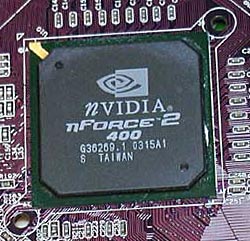
The Soltek NV400-L64 comes in a slick foil-faced embossed package that is used for many Soltek motherboards. As expected with a value board, extras are a floppy and IDE cable and nothing else. It is worth mentioning, however, that Soltek includes an extra Utility CD with their motherboards that contains PC-Cillin 2002 anti-virus, Farstone’s VirtualDrive 7 and RestoreIT 3 Lite, and Powerquest’s Partition Magic 6.0 SE and DriveImage 4.0. While these are not the latest versions of most of these utilities, they are still utilities that are frequently used. There are two versions of the NV400 listed at the Soltek website. The NV400-L64 and NV400-64 appear the same, except for the 10/100 LAN connection on the NV400-L64, which is the version that we are testing.
Soltek did not use any fancy names for the NV400-L64, but they certainly could have. You can’t help but notice that the board is purple or plum-colored. The purple board is smaller than the full size nForce2 Ultra 400 boards that we have been evaluating, and uses only seven standoffs in two rows for mounting. Full-size boards generally use nine or ten standoffs in three rows for case mounting. This small motherboard should have no trouble fitting into any standard case.
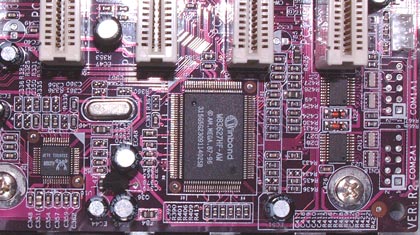
Sound is provided by the common Realtek ALC650 chip, which is compliant with AC ’97 2.2 to provide 6-channel sound. AC ’97 2.2 seems to have replaced older AC ’97 chips, which now makes 6-channel sound mainstream. Audio quality is OK for casual listening or computing, but audio enthusiasts will want to use a separate audio card for top quality. The on-board audio can be disabled in the BIOS if you wish to use a separate audio card. Only the three standard output jacks are provided for audio input and output on the I/O panel, but software that comes with the NV400-L64 does allow the three jacks to be configured for different speaker setups, and the inputs that you might need. This flexible setup is welcomed on a value board, but be aware that with three jacks, you cannot simultaneously run six speakers and a microphone. This will be important for some, and of no consequence to others. As we would expect on a board built for value, there are no SPDIF connectors or provisions for adding an SPDIF bracket to the board.
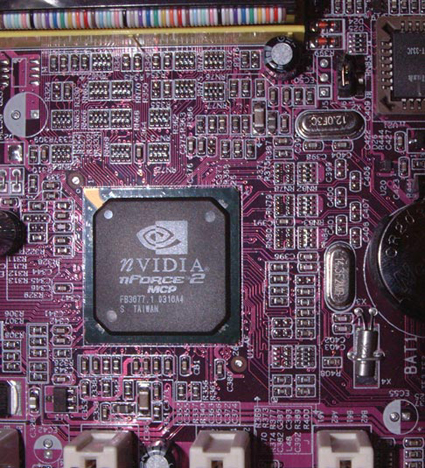
NVIDIA’s MCP SouthBridge is the value member of the MCP family. It provides USB support, support for one NVIDIA Ethernet connection, and ATA 133 IDE support. The MCP does not support NVIDIA Sound Storm or a second LAN connection — these are additions to the premium MCP-T.
The Soltek NV400-L64 uses the familiar nForce2 10/100 Ethernet for on-board LAN connection. It is becoming common to see LAN included, even on value boards like the NV400. If you prefer using a board without on-board LAN, the alternative is the NV400-64.

The NV400-L64 I/O ports are the same assortment you will find on the standard ATX backplate included with most cases. The arrangement of ports, however, does not follow the standard layout, so Soltek includes a custom backplate. There are two PS/2 ports, two serial ports, one parallel port, two USB 2.0 ports, a 10/100 LAN port, and Mic In, Line In, and Line Out, which drive the onboard sound and are configurable for rear/sub/center outputs if desired. The board does not offer any IEEE1384 Firewire ports, but we don’t normally expect to find Firewire on value motherboards.
There are two ATA133 IDE ports, supporting up to four IDE devices. It is no surprise that the NV400-L64 doesn’t have any on-board IDE RAID or SATA options.
Just two DIMM slots are included on the single-channel Soltek. The two DIMMs support up to 2GB of memory up to DDR400. While up to three DIMMs per channel can be used on the nForce2 400 chipset, Soltek decided to use just two DIMM sockets on the NV400. This is probably an acceptable arrangement on a value board, but we would like to have seen at least one more DIMM slot, since NVIDIA had intended for this Soltek single-channel to compete with KT600 boards with three DIMMs.
There are no real surprises with the Soltek NV400-L64. It includes exactly what we would expect in a value board – no more and no less. The only really distinctive thing about the appearance is the Purple color. The Soltek Utilities CD is also a nice addition for a board designed to sell for such a low price.
Soltek NV400-L64: Board Layout
The Soltek has a decent layout for a low-end board. We say this because low-end boards often have some of the strangest layouts. When the manufacturer is aiming for a price point, economy of manufacture is often more important than ergonomics.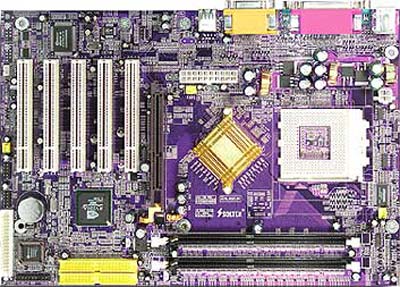
The first hint that the NV400-L64 may be a serious performer is the inclusion of both the standard 20-pin ATX connector and the AMD optional 4-pin 12V connector. While top-end AMD motherboards are implementing both of these standards, which are part of the Pentium 4 Power Supply specification, we were somewhat amazed to see both connectors on a value board. Regardless, the location of the 20-pin and the 4-pin power connectors are less than ideal. The 20-pin ATX is located to the left of the Northbridge chip, almost in the center of the board. This means you will have to snake the bulky 20-pin cable around your CPU socket and try to keep it from interfering with ventilation. We prefer a location as near to the top of the board as possible and to the right of the CPU. This works best in most case designs. The 4-pin 12V connector is in a common location, to the left of the CPU socket, but it is thankfully at the top of the board. While we prefer the 12V to the right of the CPU socket, between the CPU and DIMM slots and as close to the top of the board as possible, we can’t complain about Soltek’s positioning of the 12V connector — it does not interfere with air-flow or present cable-routing problems.
Fan connections are often in short supply on low-end boards, but Soltek includes three fan headers on the NV400-L64. This allows connection of up to three monitored fans to the board.
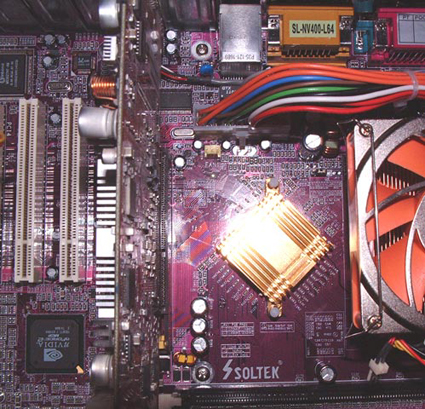
The passive heatsink used on the Northbridge has the advantage of not adding to system noise, but the one Soltek used on the NV400-L64 is much smaller than we have seen on other nForce2 boards. While it cooled effectively in our testing, it did get warmer than desired. Those planning any serious overclocking with this board may want to replace the Northbridge heatsink with a larger passive heatsink or an active cooling solution.
One advantage of a small passive or active Northbridge cooling solution is that it won’t interfere with mounting some of the larger CPU cooling solutions. There is plenty of room around the CPU socket, and we don’t believe mounting a large cooler on the CPU will create any problems. The Thermalright SK-7, which uses a clip for connection, fits with ease — even with an 80mm fan attached. However, there are no mounting holes around the CPU socket, which will be important to some. The mounting holes are not part of the current AMD specification, and we didn’t expect to find them on a value board, but they are important to many who use watercooling and very heavy heatsinks.
The Floppy connector and Primary/Secondary IDE connectors are all in compromised positions — predictable for a low-priced board. All three connectors are low on the board, which makes snaking cables more difficult. The floppy connector is in a particularly bad location, situated at the very bottom of the board. At least Soltek kept the connector to the far right of the board, which will minimize interference with slots. But Soltek is no worse than other low-end boards with respect to cable locations. A smaller board means less room to put things, and some of the small boards face some real challenges regarding layout. Our preference is closer to the top of the board, to the right of the DIMM slots; however the smaller board offers no room for the cable connections in that location.
If you have a case with drive bays to the right of the motherboard, the location of the IDE/Floppy connectors near the bottom right of the board will seem ideal. However, if your drives must mount in the upper bays of a tower case, you will probably hate the location of the IDE connectors. In the real world, users with full-tower cases will not likely choose a low-end board like the Soltek to go in their expensive cases. The Soltek layout, therfore, should work fine in the small to mid-size cases that will actually be used with this board.
Soltek NV400-L64: BIOS and Overclocking
Soltek uses the familiar Award BIOS on the NV400-L64. Our board was tested with the shipping v1.1 BIOS. The NV400 BIOS will be a pleasant surprise for enthusiasts who want to tweak the Soltek for the best possible performance. The board timing options and overclocking options are much more than you would expect on a low-priced motherboard.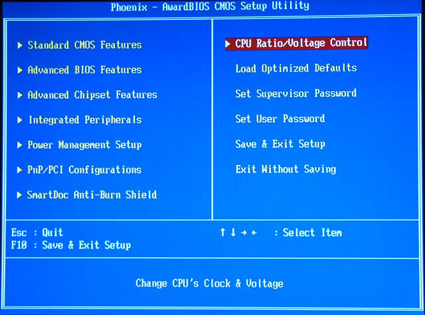
The Main BIOS Screen layout includes the standard options, plus CPU Ratios/Voltage Control, Advance Chipset Features for system timings, and SmartDoc Anti-Burn.
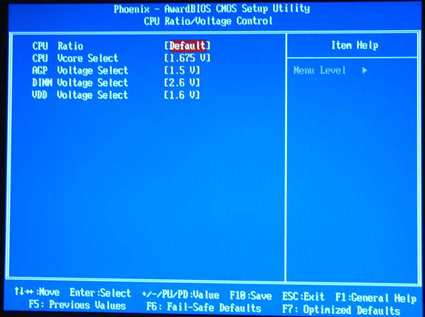
Voltage selection and CPU ratios are adjusted in the CPU Ratios/Voltage Control menu. Voltage adjustments are included for Core Voltage, DIMM, AGP, and also (surprisingly) adjustments for chipset (VDD) voltage.
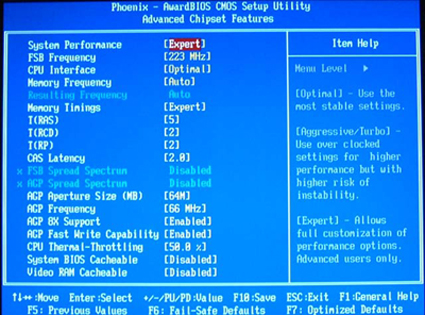
System and Memory Timings are adjusted in the Advanced Chipset Features menu. Unlike many other boards, the NV400-L64 has the adjustments for FSB in Advanced Chipset Features. A pleasant surprise is that Soltek includes a 'Fixed' option for PCI/AGP speed, which is adjustable from 50-100 AGP (PCI is half this value) in 1 MHz increments. While there is a full range of memory timing adjustments, one area of concern here is the Memory Frequency. The only option available is 'Auto', which means the memory can only be set to the memory speed programmed in the SPD. This will be a disappointment for many who like to adjust memory speeds for best performance.
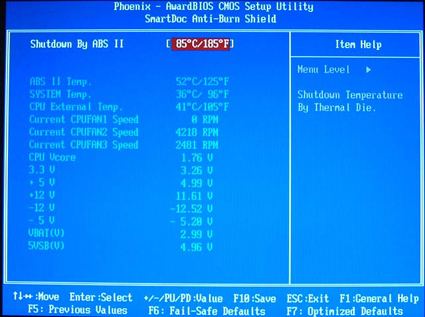
PC Health functions are featured in the SmartDoc Anti-Burn Shield section. Monitoring functions include System, CPU, and ABSII temperatures, fan speed monitoring for three on-board fan connections, Vcore, and Power Supply readings for all rails. The ABSII temperature monitoring appears to be reporting AMD sensor temperatures, as the reported temperatures are quite a bit higher than reported System temperatures. Soltek includes a Hardware monitoring utility on their installation CD for reporting the values in Windows.
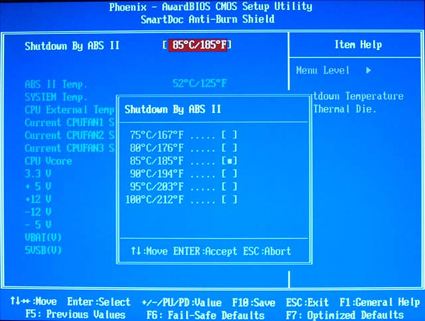
The Anti-Burn Shield II option has adjustments for setting the system shutdown temperature in the event of overheating. With the lack of attention paid to Athlon overheating problems in the past, we are pleased to see this concern addressed by Soltek on a board that will sell into the mainstream market.
BIOS options for the NV400-L64 are surprisingly complete. What we found here is very much in line with Soltek’s reputation of building economical boards that will still satisfy the computer enthusiast.
FSB Overclocking Results
With a complete selection of overclocking options on the Soltek, we had high expectations for the overclocking performance of the board. For FSB overclocking, the following setup was used on the NV400-L64:| Front Side Bus Overclocking Testbed | ||
| Default Voltage | Maximum Overclock | |
| Processor: | Athlon XP 2500+ (Barton Core) | Athlon XP 2500+ (Barton Core) |
| CPU Vcore: | 1.650V (default) | 1.775V (default) |
| Cooling: | Thermalright SK-7 with 80mm Thermaltake Fan | Thermalright SK-7 with 80mm Thermaltake Fan |
| Power Supply: | Powmax 350W | Powmax 350W |
The above overclocking setup at default voltage allowed us to reach a stable FSB of 215MHz. Considering that the DFI NFII Ultra reached a stable 223MHz at the same default settings, we were mildly disappointed in the Soltek overclocking performance compared to the best nForce2 Ultra 400 board. However, when we increased our voltage settings, we were able to reach a stable overclock of 225MHz at 1.775V. While this is not quite as good as the DFI NFII Ultra, it is very close, and it suggests that the Soltek design may require a bit more voltage than higher-end boards to reach the same overclocking heights. Our experience with higher voltages on VDD, in particular, suggests that very high overclocks can be reached with the NV400-L64 — if you are comfortable using higher voltages with this board. With the voltage and adjustment options available on the Soltek, and the low price of the board, we would not be at all surprised to see overclockers modding this board and pushing it to new performance levels. Out of the box, it is a decent, but not outstanding, performer at default voltage. With higher voltages, it becomes one of the best overclocking nForce2 boards that we have tested.
The Soltek NV400-L64 has a wide range of multiplier adjustments, available from 5X all the way up to 22X.
Soltek NV400-L64: Stress Testing
We performed stress tests on the Soltek NV400-L64 in these areas and configurations:1. Chipset and motherboard stress testing, conducted by running the FSB at 215MHz.
2. Memory stress testing, conducted by running RAM at 400MHz with one DIMM slot filled and at 400MHz with both DIMM slots filled, at the lowest memory timings possible.
Front Side Bus Stress Test Results:
As standard practice, we ran a full range of stress tests and benchmarks to ensure that the Soltek NV400-L64 was absolutely stable at each overclocked FSB speed. These stress tests included Prime95 torture tests, which were run in the background for a total of 24 hours.In addition, we ran several other tasks: data compression, various DX8 and DX9 games, and apps, like Word and Excel. Moreover, Prime95 was running in the background. Finally, we ran our benchmark suite, which includes ZD Winstone suite, Unreal Tournament 2003, SPECViewperf 7.0, and Gun Metal Benchmark 2. While we were able to boot and run some tests at speeds as high as 223MHz FSB and at default voltage on the NV400-L64, 215MHz was the highest achievable overclock without encountering any reliability issues.
Memory Stress Test Results:
This memory stress test is very basic, as it simply tests the ability of the NV400-L64 to operate at its officially supported memory frequency (400MHz DDR) and at the lowest supported memory timings that our Corsair TwinX LL modules support:| Stable Dual DDR400 Timings (1/2 banks populated) |
|
| Clock Speed: | 200MHz |
| Timing Mode: | N/A |
| CAS Latency: | 2.0 |
| Bank Interleave: | N/A |
| RAS to CAS Delay: | 2T |
| RAS Precharge: | 4T |
| Precharge Delay: | 2T |
| Command Rate: | N/A |
It’s not startling to see the Soltek NV400-L64 run at the lowest timings that we could establish on the board. We often see 2-4-2-2 timings working well with better nForce2 boards in dual-channel mode. So, we certainly predicted single-channel mode to run at these maximum speed timings. The nForce2 Ultra 400 chipset, like Corsair LL memory, seems designed to give the lowest possible memory timings, and the nForce2 400 single-channel is behaving in the same manner. As we have seen in previous reviews on memory performance, this does not always translate into the fastest memory performance. Nevertheless, lowest memory timings is one means of comparing motherboards. It is most useful when comparing boards based on the same chipset.
Filling both available memory banks is more strenuous on the memory subsystem than testing one bank in single-channel mode, as it tests two DIMMs running 400MHz DDR at the most aggressive memory timings available in the BIOS:
| Stable
DDR400 Timings (2/2 banks populated) |
|
| Clock Speed: | 200MHz |
| Timing Mode: | N/A |
| CAS Latency: | 2.0 |
| Bank Interleave: | N/A |
| RAS to CAS Delay: | 2T |
| RAS Precharge: | 4T |
| Precharge Delay: | 2T |
| Command Rate: | N/A |
We were pleased that the Soltek handled the same aggressive memory timings with two Corsair DIMMs installed as with one DIMM installed. While there are only two DIMM slots available on the Soltek, both slots can be filled with the confidence that you can run at the most aggressive settings handled by the memory. Please keep in mind that the fastest timings do not always equate to the best performance when it comes to memory. It is also true that the real world performance difference between aggressive memory timings and more relaxed memory timings, such as SPD, can be very small. Unless your goal is to squeeze every last bit of performance from your system, SPD timings will work just fine 99% of the time.
We tested all these memory timings using several stress tests and general applications to guarantee stability. Prime95 torture tests were successfully run at the timings listed in the above charts. We also ran Sciencemark (memory tests only) and Super Pi. None of the three stress tests created stability problems for the Soltek NV400-L64 at these memory timings.
Soltek NV400-L64: Tech Support and RMA
For your reference, we will repost our support evaluation procedure here:
The way our Tech Support evaluation works is first, we anonymously email the manufacturer's tech support address(es), obviously not using our AnandTech mail server to avoid any sort of preferential treatment. Our emails (we can and will send more than one just to make sure we're not getting the staff on an "off" day) all contain fixable problems that we've had with our motherboard. We allow the manufacturer up to 72 (business) hours to respond, and then we will report whether or not they responded within the time allotted, and if they were successful in fixing our problems. In case we don’t receive a response before the review is published, any future responses will be added to the review, including the total time it took for the manufacturer to respond to our requests.
The idea here is to encourage manufacturers to improve their technical support as well as provide new criteria upon which to base your motherboard purchasing decisions. As motherboards become more similar everyday, we have to help separate the boys from the men in as many ways as possible. As usual, we're interested in your feedback on this and other parts of our reviews, so please do email us with your comments.
Soltek’s RMA policy could not be found by visiting their U.S. website at http://www.soltekusa.com. Soltek lists sales/support operations in Taiwan, Europe, and South America, but there are no listings for offices in the USA. We were told that all RMA requests should be directed toward the dealer who sold you the board. In the event of problems there, requests can be addressed to [email protected]. The lack of an identifiable US presence from Soltek is of great concern, but in fairness to Soltek, our requests to their Taiwan headquarters were all answered promptly, and the Soltek staff was very helpful. FAQ’s, downloads, and product information are available at their main site. You will be linked to this main site if you visit www.soltekusa.com.
Technical Support is also available by email, which is listed under "Contacts" at the main site. Soltek's tech support response time was simply outstanding. Soltek Taiwan's response came in just 10 (clock) hours after our original email. The reply from the technical support representative was a sincere attempt to solve our problem, but the advice given showed a lack of technical experience by the support representative. While the advice given was one of the possible solutions to our problem, it would have been third or fourth on the list of suggested fixes by an experienced technician. This is our very first review of a Soltek product, so we do not want to judge the overall quality of Soltek Technical Support on one issue. Their incredibly fast response left a very positive impression of Soltek’s commitment to customer satisfaction. Had the response been more technically savvy in its recommendations, we would rate Soltek near perfect. We continue to be surprised at how good Technical Support can be from some of the smaller companies. The giants in the industry should be embarrassed at how poorly they often treat customers in comparison to responses similar to what we see from companies like Soltek.
Those who cannot find a local Soltek resource should send their Tech Support inquiries to the Taiwan main site. If our experience is any indication, we think you will be pleased at the responsiveness in your communications with Soltek.
Performance Test Configuration
| Performance Test Configuration | |
| Processor(s): | AMD Athlon XP 3200+ (400MHz FSB) |
| RAM: | 2 x 256MB Corsair PC3200 TwinX LL (v1.1 or v1.2) Modules |
| Hard Drive(s): | WMaxtor 120GB 7200 RPM (8MB Buffer) Western Digital 120GB 7200 RPM Special Edition (8MB Buffer) |
| Bus Master Drivers: | NVIDIA nForce version 2.03 (January 30, 2003) VIA 4in1 Hyperion 4.47 (May 20, 2003) |
| Video Card(s): | ATI Radeon 9800 PRO 128MB (AGP 8X) |
| Video Drivers: | ATI Catalyst 3.6 |
| Operation System(s): | Windows XP Professional SP1 |
| Motherboards: | Soltek NV400-L64 (nForce2 400 SC) @ 200.5MHz FSB DFI NFII Ultra LanParty (nForce2 Ultra 400) @ 201.35 MHz FSB Gigabyte 7VT600 1394 (KT600) @ 202.78MHz FSB Gigabyte 7NNXP (nForce2 Ultra 400) @ 202.77MHz FSB Epox 8KRA2+ (KT600) @ 202.44MHz FSB |
All performance tests that ran on nForce2 400 (SC)/nForce2 Ultra 400 (DC) motherboards utilized two 256MB Corsair TwinX LL PC3200 (v1.1 or v1.2) modules set to SPD timings in DDR400 mode. Dual-channel mode was used on nForce2 Ultra 400 boards, and two DIMMs working as single-channel were used on the nForce2 400 Soltek NV400-L64 board.
All performance tests that ran on the KT600-based motherboards used two 256MB Corsair TwinX LL PC3200 (v1.1 or v1.2) Corsair modules in DDR400 mode. KT600 memory timings did vary slightly among the motherboards, with the Asus A7V600 requiring a Ras-to-Cas of 3 for stable operation and other KT600 boards requiring a Ras-to-Cas setting of 2. 4-bank interleave and the highest available timing option (Turbo or Ultra) was used.
Performance tests were run using the ATI 9800 PRO 128MB video card, with AGP Aperture set to 128MB with Fast Write enabled. The ATI 9800 PRO is the new Anandtech video card standard for reviews.
Additions to Performance Tests
Benchmark testing is dynamic, and we have added several new benchmarks to our standard Test Suite.1) ZD Labs Internet Content Creation 2003 – This benchmark has just been updated by ZD Labs and includes many new features in the Benchmark Suite, such as Media Encoding. It also uses the most up-to-date versions of Multimedia Creation software, which is rapidly changing as new software tools are released.
2) ZD Labs Business Winstone 2002 – ZD Labs Business Winstone has been around for many years and is a widely quoted Benchmark for measuring system performance. It basically provides a similar benchmarking suite to Sysmark 2002 Office Productivity.
3) Gun Metal DirectX Benchmark 2 – This demo/benchmark from Yeti Labs is one of the first DX9 game-based benchmarks available. Unlike some older benchmarks, such as Quake 3, that generate insane FPS ratings in the 300’s, we see performance numbers in the 30 to 40FPS range with current DX9 cards.
To give AnandTech readers a feel for how some of the newer benchmarks compare to the more familiar benchmarks used in past reviews, we have posted results for both of these new benchmarks and Sysmark 2002, as well as all the games that have been a part of our standard benchmark suite.
New Hardware
With the release of DirectX 9 late in 2002, the availability of Benchmarks to test DX9, and the availability of DX9-supporting video cards from both NVIDIA and ATI, we are now using the ATI Radeon 9800 PRO as our video standard in all hardware tests.Content Creation and General Usage Performance
Media Encoding and Gaming Performance
High End Workstation Performance - SPEC Viewperf 7.0
High End Workstation Performance - SPEC Viewperf 7.0 (continued)
Comments on Performance Tests
The gaming benchmarks certainly tell a remarkable story when we look at the Soltek NV400 single-channel board. In almost every gaming benchmark — even the very demanding Gun Metal DX9 benchmark — the NV400-L64 finishes first or second. This puts it on a par with the best nForce2 Ultra 400 boards, at least in the gaming arena.Although the Soltek performs well in Content Creation, General Usage, and MPEG-4 Encoding benchmarks, it is not a clear winner, falling slightly behind the best Ultra 400 boards.
Finally, when we look at the very demanding High-end Workstation Performance Benchmarks, we find the NV400 falling significantly behind the Ultra 400 boards. Apparently, SPECViewperf is very sensitive to memory bandwidth and it shows that the lower latency of a single-channel memory solution cannot always offset the loss in memory bandwidth.
Final Words
The Soltek NV400-L64 is a bargain-priced, single-channel nForce2 400 board whose primary reason for being is to compete with the VIA KT600 with a lower-cost NVIDIA chipset, and to provide compelling value for mainstream users. It meets both of these goals very well, and has to be considered a roaring success.The surprising performance of the single-channel nForce2 400, however, also makes the NV400-L64 the ideal board in situations that you might not have considered. Its top-notch gaming performance makes it an ideal choice for a top-performing gaming rig, and its low price will save the gamer some money, to be spent on a better video card, for example. While the gaming performance of the Soltek is excellent, it is not a knock-out punch, as its performance is very close to the gaming performance of top Ultra 400 boards.
For mainstream use in multimedia creation and general office work, the NV400-L64 is also a competent performer. If you are working on a limited budget and/or desire an excellent price point, you won’t be making any performance sacrifices with this Soltek. In fact, you may also save money buying memory. Top performance can be achieved on the NV400-L64 with just one stick of memory, compared to nForce2 Ultra 400 boards that need a matched pair of DIMMs for best performance.
Despite these positive remarks, there are some weaknesses in the nForce2 400 chipset. Applications like SpecViewperf 7.0 show that there are trade-offs with the single-channel solution. In truly demanding workstation applications, the Soltek NV400-L64 is no substitute for a top nForce2 Ultra 400 dual-channel solution.
It’s hard not to get excited about a board that sells for about $70 and outperforms the majority of Athlon boards in gaming. It’s easy to recommend the Soltek for a top-notch gaming rig, as well as a mainstream system that provides top-performance with few frills at a value price. It is not, however, the board that beats the nForce2 Ultra 400 in demanding applications.







